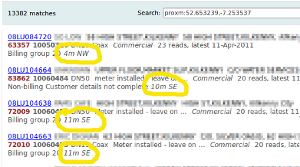We’ve been busy over the last couple of months, adding new functionality to Temetra
Advanced Searching
 We’ve put in new search functions that allow for super-fast, ranked results, with capacity to work with very large networks of meters. As the number of meters in Temetra increases, and the size of individual customer networks gets much larger, we need to ensure that searching remains fast and relevant.
We’ve put in new search functions that allow for super-fast, ranked results, with capacity to work with very large networks of meters. As the number of meters in Temetra increases, and the size of individual customer networks gets much larger, we need to ensure that searching remains fast and relevant.
In particular, the more words you use in your search, the more accurately it will find meters, but we can also change the priority of different information on the meter. So for example, if a customer has 10 meters and the search results return all 10, we can make sure the meter with the most recent readings is at the top, since it’s most likely this is the meter you’re interested in.
Additionally, the new search function is aware of location of meters with GPS. This allows you to search by proximity, so if you’re looking at a meter, we can you meters that are closest, ranked by closeness.
Unaccounted For Water (UFW)
 Unaccounted for water calculations are now automated in Temetra based on standard formulae. Enter the number of households, commercial usage, and length of downstream pipework, and Temetra will automatically calculate the estimated UFW.
Unaccounted for water calculations are now automated in Temetra based on standard formulae. Enter the number of households, commercial usage, and length of downstream pipework, and Temetra will automatically calculate the estimated UFW.
This is particularly useful for smaller areas of your network, where it’s difficult to justify the extra cost of telemetry and detailed metering. Local caretakers can enter readings from the meter and see changes in UFW, allowing them to compare meters in their area and their UFW profile.
Scheduled Fixed Date Readings
As the price of GSM data loggers and other fixed network telemetry drops, it’s no longer the preserve of very large users. We have more and more loggers being deployed for billing customers, so we’ve introduced an automated way of transferring a small subset of the available data for billing. If a meter is getting a meter index every 15 minutes, but a billing read is only required once per month, you can now configure a schedule to extract the index for billing.
Temetra Reader version 3
 We’ve come a long way since version 1.0 of Temetra Reader in July 2007. With many new features, upgrades and improvements along the way, we’re now introducing version 3.0.
We’ve come a long way since version 1.0 of Temetra Reader in July 2007. With many new features, upgrades and improvements along the way, we’re now introducing version 3.0.
New in this version are the ability to simultaneously read Itron and Elster wireless transponders from a single handheld, and improved over-the-air upgrades. This new version will provide us with a spruced up platform on which to base our next round of features.
